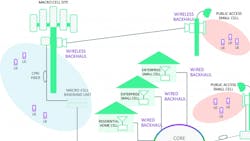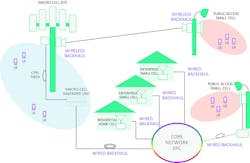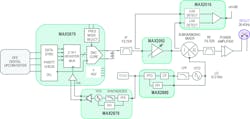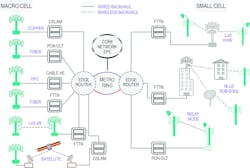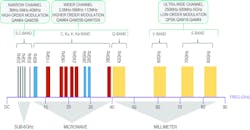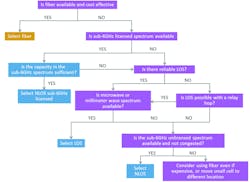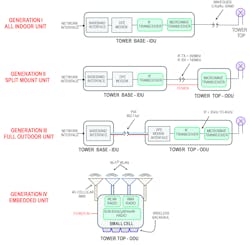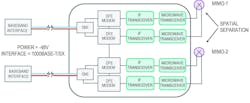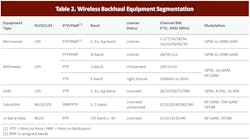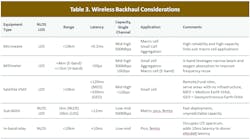Introduction
This two-part article series reviews mobile wireless backhaul systems deployed in 4G heterogeneous (HetNet) networks. Different equipment categories and emerging equipment segment trends are presented. Microwave, millimeter wave, and sub-6GHz radio applications in small-cell and macro-cell base stations are discussed. The role of radio frequency (RF) analog integration and high-performance RF building blocks is explored, with a focus on point-to-point microwave systems and broadband satellite systems.
This article, Part 1 of the series, examines wireless backhaul market drivers, equipment trends, and the toolbox of different backhaul solutions deployed across cellular radio-access networks. Equipment segmentation and equipment configurations are discussed. Considerations and selection criteria are presented to help guide the backhaul-solution decision process.
Part 2 of this article series focuses on point-to-point microwave and broadband satellite systems typically used for backhauling in macro-cell and small-cell base stations. Techniques to improve radio-link spectral efficiency and radio lineup scenarios are discussed. The role of RF analog integration and RF building blocks is explored with relevant solutions.
The Role of Mobile Backhaul
Mobile backhaul is provisioned throughout the cellular network to transport voice and data traffic between the access layer and core network (Fig. 1). Wireless equipment at the access layer includes macro-cell base stations, small-cell base stations, and distributed antenna systems (DAS). Wired transport and wireless transport are the two types of mobile backhaul deployed across the radio access network (RAN). With the emergence of heterogeneous networks, mobile backhaul has become a critical RAN element for 4G LTE-Advanced (LTE-A).
The 4G network is evolving into a heterogeneous network where different classes of small-cell base stations and DAS installations are coordinated, working in concert with macro-site base stations. A HetNet topology improves cellular network capacity and coverage to support the exponential growth in mobile traffic. Consequently, HetNets will deliver ubiquitous connectivity with exceptional quality of experience for 3G/4G mobile users. Backhaul brings together mobile broadband users, small cells, DAS, macro cells, and the core network.
Wireless Backhaul HetNet Challenges
The emerging HetNet has created a need for diverse wired and wireless mobile backhaul solutions. Small-cell installations are planned for indoor and outdoor non-telecom asset sites like street lamp posts, utility poles, and other urban structures (also called “street furniture”). The sites can be located throughout corporate campuses or public places. Depending on the installation scenario, each small-cell site has specific requirements for power sourcing, power budget, and backhaul transport. Meanwhile, conventional macro-cell base stations will continue to upgrade network capacity, further driving demand for high-throughput backhaul.
The breadth and velocity of planned HetNet deployments, along with the broad range of installation scenarios, are challenging service operators to take a “toolbox” approach for meeting their backhaul needs. Operators rely on a toolbox of different wired and wireless transport technologies for their diverse backhaul requirements. Wireless technology itself emerges as an important tool in serving their backhaul needs. Wireless backhaul has many advantages versus wired technologies, but wireless solutions also present unique design challenges: the need for spectrally efficient radio links, low operating power, small form factor, and environmentally hardened high-reliability equipment. RF analog integration also plays an important role, as shown in Fig. 2. Here a typical microwave radio transmitter relies on RF analog integration and RF building-block solutions to shrink size, lower power, and improve dynamic performance.
The following topics provide an understanding of the different backhaul solutions and market forces driving mobile backhaul deployments. Equipment and technology trends within the wireless backhaul segment are presented. Examples highlight how RF analog integration and RF building blocks assist the point-to-point microwave and broadband satellite backhaul solution toolbox.
Mobile Backhaul Equipment Types
Wired and wireless backhaul solutions employ broadband technologies that vary in terms of physical media and access method (Fig. 3). Wired backhaul physical media include copper wire, hybrid fiber-coaxial (HFC) cable, and single-mode and multimode fiber-optic cable. Transport access technologies are fractional-T/E carrier (T1/E1), digital subscriber line (DSL), pseudowire, Ethernet, wave division multiplexing (WDM), and gigabit passive optical network (GPON). The choice of wired backhaul is dictated by the availability of physical media, leasing cost, and data throughput requirements.
Wireless backhaul is needed when base stations do not have access to copper, HFC, or fiber transport. Wireless backhaul is also attractive when time to deployment is critical or when leasing costs are prohibitive. It is estimated that nearly 70% of worldwide LTE base-station installations use wireless backhaul.1 The methods of delivering wireless backhaul transport are line-of-sight (LOS) microwave, line-of-sight millimeter wave, non-line-of-sight (NLOS) sub-6GHz microwave, broadband satellite links, and inband or out-of-band relay nodes.
Market Drivers for Wireless Backhaul
There are four primary market drivers in the mobile wireless backhaul segment:
- Mobile traffic: exponential growth in mobile broadband traffic.
- Mobile subscribers: rapid growth in mobile broadband subscriptions.
- RAN density: increase in the number and type of base-station deployments.
- Data rate evolution: air-interface peak-data-rate evolution (Fig. 4).
From 2013 to 2018 mobile traffic will grow at a 60%2 compounded annual growth rate (CAGR) and broadband subscribers (LTE and HSPA) will grow at 27%3 CAGR. In 2018 this translates to about 16 Exabyte/month of mobile traffic and 6 billion broadband subscribers. Over the next four years the number of macro-cell base-station RF-transceiver shipments will increase 51%,4 and small-cell base-station shipment growth is forecast at over 43% CAGR.5 The result will be significant RAN densification and network capacity gains. The evolution from 3G to LTE-A has seen theoretical peak downlink data rates increase 10x from 2010 to 2014, and will extend beyond 3Gbps throughput when 5G is adopted in the future.
Convergence of these four primary market drivers is accelerating demand for high-capacity wireless backhaul solutions. As mobile traffic, mobile subscribers, RAN density, and peak data rates all increase, then base-station capacity and wireless backhaul capacity must also increase.
Technology Drivers for Wireless Innovation
There are four technology drivers common to all wireless backhaul equipment used in macro- and small-cell base-station applications:
- Spectrally efficient, high-throughput radio links.
- Low operating power.
- Small form factor.
- High reliability.
Spectrally efficient radio links are critical because the available RF spectrum is a finite and valuable resource that must be used efficiently. Further, licensing fees for more RF spectrum can burden the network operator’s total cost of ownership. High throughput is important because backhaul capacity, at a minimum, must match the base-station capacity; otherwise network performance is compromised. Low operating power is needed to minimize electrical energy usage which yields lower operational expenditure (OPEX) and shrinks carbon emissions footprint. Low operating power also reduces heat dissipation, thus improving system reliability and allowing smaller and lighter enclosures. A small-form-factor, zero-footprint solution is important because site and tower leasing costs are proportional to occupied space. So a smaller form factor reduces OPEX by lowering leasing cost. High reliability, finally, is vital to achieving “four nines” (i.e., 99.99%) or better service availability and minimizing maintenance costs.
The four technology innovation drivers are common to macro- and small-cell base-station applications. However, each base-station type and deployment scenario demands a unique and optimal wireless backhaul solution. This need thus requires a solution toolbox approach to best serve each wireless backhaul application.
Wireless Backhaul Toolbox
The HetNet comprises four general classes of base station: (1) macro cell, (2) metro cell, (3) pico cell, and (4) femto cell. Table 1 contrasts the types of base station, deployment scenarios, and the toolbox of possible wireless backhaul solutions.
Wireless backhaul radios operate over a wide spectrum of licensed and unlicensed RF bands extending to 80 GHz (Fig. 5). The RF spectrum for wireless backhaul ranges from sub-6GHz NLOS to C/Ka/Ku-band microwave LOS, and Q/V/E-band millimeter wave LOS. Each RF band has spectrum restrictions, channel bandwidth limitations, and propagation characteristics. Channel bandwidth can vary from 5 MHz to 160 MHz in NLOS systems; from 3.5 MHz to 56 MHz in microwave LOS systems; or from 28 MHz to 112 MHz and 250 MHz to 5 GHz in millimeter-wave systems. All these specifications impact the type of modulation and carrier-to-noise ratio, in turn dictating capacity trade-offs and link distance.
Modulation can be simple QPSK used with wide-channel bandwidths or for operation in poor atmospheric conditions under low signal-to-noise-ratio (SNR) channel conditions. Conversely, high-order modulation up to QAM-2048 can be used with narrow bandwidths or for operation in high-SNR clear atmospheric conditions. Depending on link capacity requirements, installation scenario, SNR, and atmospheric conditions, the data throughput can range from 100 Mbps to 10 Gbps. The different characteristics for each wireless backhaul method are highlighted in Table 2.
Selecting an optimal wireless backhaul solution depends on system performance objectives and resource availability. System performance is predicated upon required capacity or data throughput, acceptable latency, expected quality-of-service, system scalability, and total cost of ownership (TCO). TCO comprises CAPEX and operational expense (OPEX) including energy cost, spectrum licensing fees, and site acquisition cost. Resource availability includes available RF spectrum, line-of-sight accessibility, site restrictions, prevailing atmospheric conditions, radio-link distance, and time to deployment. Table 3 summarizes some of these considerations. A decision tree like that shown in Fig. 6 can help guide the backhaul selection process.[6]
Equipment Configurations and Trends
Wireless backhaul equipment requires four key components: the antenna, radio transceiver, modem, and interface. The antenna transmits and receives electromagnetic waves. The radio transceiver handles RF carrier frequency translation to and from the baseband. The modem modulates and demodulates the radio signals, and the interface moves information between the radio and TDM/IP transport. Differentiation among the four equipment types is distinguished by partitioning of the radio, modem, and interface. Figure 7 identifies the four different types of equipment configurations: all indoor unit (AIU), split mount unit (SMU), full outdoor unit (FODU, also called all outdoor unit, or AODU), and embedded.
The evolution of Generation-I through Generation-IV equipment is characterized by a recognizable trend: moving more equipment up to the tower top, closer to the antenna. This trend seeks a zero-footprint design that eliminates indoor cooling cost, the need for indoor cabinet space, and RF signal loss.
For macro-cell base-station applications the migration from indoor units to full outdoor units lowers power, improves signal quality, and lowers OPEX. Macro cells benefit from the FODU partition because RF loss in the waveguide or coaxial cable is minimized, or eliminated, which lowers RF power output and improves receiver input sensitivity. FODU reduces the indoor space needed for equipment housing; it does not require the special heating and cooling associated with indoor units. Together, these benefits yield lower operating cost and better system performance.
In small-cell base-station applications the adoption of an embedded configuration means that systems can achieve a zero-footprint with lower equipment cost. Small cells benefit from an embedded partition because a single unit houses the WAN, WLAN, and wireless backhaul radio functions. Now system size shrinks and installation is simplified. Also because many small-cell deployments rely on E/V-band backhaul operating at 60 GHz to 80 GHz, the RF losses associated with radio and antenna connections are significantly reduced.
Figure 8 is a high-level block diagram of FODU with Power over Ethernet (PoE). It employs advanced radio communication techniques that improve spectral efficiency and ensure link availability. The techniques include co-channel dual polarization (CCDP) and multiple-input, multiple-output (MIMO) spatial multiplexing with hot standby redundancy. The diagram illustrates how radio channel density is increasing. It also highlights why RF analog integration plays a critical role in achieving compact size. Part 2 of this article series covers system partitioning in more detail along with relevant RF solutions.
Conclusion
This article examined wireless backhaul applications, equipment trends, and the solution toolbox available for 4G HetNet deployments. It presented different wireless technologies and radio bands used in microwave, millimeter wave, sub-6 GHz, and satellite backhaul systems. It explained how wireless backhaul equipment is evolving toward single integrated units featuring lower operating power, smaller size, and better radio performance. The caveat to achieve this feature set is a requisite for RF analog integration.
Part 2 of this article series focuses on point-to-point microwave and broadband satellite systems typically used in macro-cell and small-cell base stations. Techniques to improve radio-link spectral efficiency and radio lineup scenarios are discussed. The role of RF analog integration and RFIC building blocks is explored, and relevant RF solutions are presented.
References
1. “Wireless Backhaul Spectrum Policy Recommendations and Analysis Report,” GSMA, November 2014.
2. Cisco Virtual Networking Index: Global Mobile Traffic Forecast Update, 2014-2019, Cisco, February 3, 2015.
3. Ericsson Mobility Report, On the Pulse of the Networked Society, June 2014.
4. “2015 Macro Base Stations” (excluding China Mobile), Mobile Experts.
5. “Small cell market on track to increase 56% this year,” Infonetics Research, April 2014.
6. “Small-cell backhaul: Industry trends and market overview,” Senza Fili Consulting, 2013.
About the Author
Damian Anzaldo
Principal Member of Technical Staff—Field Applications
Damian Anzaldo is a principal member of technical staff in field applications at Maxim Integrated. During his time with Maxim, he has published numerous articles and circuit ideas on topics ranging from power and battery management to precision data conversion and RF/wireless communications. His past roles at Maxim include high-speed data converter product definer within the high-speed signal processing group, and technical marketing manager for the wireless communication segment. Anzaldo holds a BSEET from Temple University and an ASET from Penn State University.
